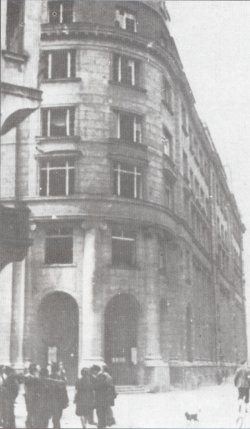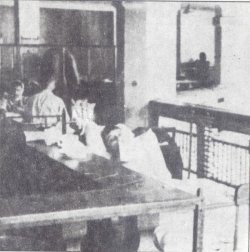
The PKO building
Medical services during the Warsaw Uprising
Downtown North
Downtown North became a separate district during the Uprising and was connected with Downtown South only through the barricade and a ditch running through Jerozolimskie Avenue between the 17 and 22 buildings. From the west, the district boundary was at Towarowa Sreet, and from the east at Nowy ¦wiat Street. After the fall of the Old Town, the northern defensive line ran along Krochmalna Street, Grzybowska Street and Królewska Street. After capturing the Prudential, the Main Post Office building, the PAST-a building, the Police Station and the Nordwache, insurgents controlled the district until the uprising capitulation on 2nd of October, 1944.
There were no stationary hospitals in the Downtown North area. For that reason, there was created a network of field hospitals.
The PKO field hospital located in the building complex between the following streets ¦więtokrzyska, Jasna, Moniuszki and Marszałkowska became the best equipped and the largest hospital in the central part of the Downtown district.
The driest basements of the building, situated under the courtyard, were adapted for hospital, and because the number of the wounded constantly increased, the fan room was designated as an additional room to accommodate the wounded. The advantage of such a location was electric light, fans and sanitary facilities. The hospital room was spacious, warm and dry. A room for a few beds for the wounded officers was adjacent to the main hospital room. Next to it was located women's ward with 10 beds, the dressing room was located at the entrance to the shelter. A separate place was designated for the wounded German prisoners of war. The wounded were laid in clean beds. The hospital medical staff was able to carry out all surgical procedures.
The PKO building was under constant fire as Germans knew that the building was the headquarters of the uprising commander, ColonelAntoni Chru¶ciel pseudonym "Monter". Due to a massive air bombardment carried out on 30th of August, over-the-ground levels of the buildings as well as the shelters were destroyed. Bombardments carried out on 4th of September made part of the ceilings collapsed, and set the building on fire. Evacuation of the entire hospital was ordered. In spite of the raging fire, most of the equipment, and medicines and dressings were saved from the fire. The next day after the evacuation, ruins of the PKO building were completely destroyed.
The wounded were moved under the cover of night, and the evacuation was helped by numerous medical patrols and soldiers from combat units. The lightly wounded together with some of the hospital personnel, walked through Jerozolimskie Avenue and were placed in hospitals in the Downtown South area. The severely wounded were placed in hospitals at Chmielna Street. During its operation, the hospital treated about 400 of the severely wounded.
The Evangelical Hospital at 35 Królewska Street started its duties on 1st of August as a hospital with 35 beds. The hospital was located in the building of the Female Commercial High School, to which location the school was moved by Germans in May 1943 from Karmelicka Street because of the uprising in the Warsaw ghetto. During the first assault on the PAST-a building, the hospital was under constant fire for 6 days. After destruction of the hospital building, an evacuation order for the hospital came through on 6th of August, and instructed to relocate majority of the wounded to the hospital new location at 5 Szpitalna Steet (corner of Przeskok Street) and some of the wounded were to be relocated to premises at 8 Szpitalna Street, to a hospital with 25 beds.
A heavy aerial bombardment on 4th or 5th of September destroyed the adjoining building at 6 Szpitalna Street. An order was given to move the wounded and sick to the hospital at Górskiego Street. Shortly after the wounded were moved to the new location, the hospital building was bombarded and many of the patients got killed. In agreement with the Government Delegacy of the District, the hospital was moved in September to Downtown South at 12 Mokotowska Street and 16 Mokotowska Street, i.e. to the Methodists and a private apartment of Kazimiera Kluczyńska. In the final phase of the uprising, the hospital opened an isolation ward. On 3rd of October, after the capitulation, the hospital was moved, through the Pruszków camp, to Milanowek.
Several field hospitals operated at Chmielna Street
.
The Surgical Elite Hospital operated at 28 Chmielna Street in the "Terminus" Hotel. After the fall of the Old Town, the hospital admitted the wounded evacuated from there through sewers, and a few days later, part of the patients and the medical staff of the partially bombed PKO Hospital found shelter at this hospital. At that time, the number of the wounded at the hospital reached 300 people, which significantly worsened the conditions at the hospital. The hospital also operated on the other side of the street at 31 Chmielna Street.
Field hospital at 20 Chmielna Street corner of Bracka Street was opened at the end of August, after the hospital at 7 and 13 Chmielna Street ceased to exist due to its location too close to the front line. Conditions at this hospital were very hard, patients were laid down in the basement, and a patient who had a mattress or a coat to cover themselves could consider themselves lucky. There were around 60 beds and the hospital was overcrowded. There was also a hospital at 21 Chmielna Street.
There were also small hospitals at Jasna Street near the PKO, located at the "Adria" restaurant at 11 Moniuszki Street, and another one at 2/4 D±browski Square located in private apartments.
The Security Corps (KB) insurgency hospital was located at 5 Boduena Street. After the bombardment of 15th of September which destroyed the hospital building, 107 of the wounded KB soldiers got killed under its rubble.
The wounded were also treated at the House of the Jabłkowscy Brothers at 25 Bracka Street.

Hospital at the House of the Jabłkowscy Brothers
There were organised several field hospital in the north-western part of Downtown, in the vicinity of the operational theatre of the Groups "Chrobry II" and "Gurt".
The field hospital at 34 Chmielna Street was established at the private clinic of Dr Weber. The hospital mainly treated the severely wounded and had about 70 beds.
Field hospital of the "Gurt" Group was organised at 58 Złota Street, in the former Niklewski Gymnasium. In the first days of the uprising, there was prepared a dressing station there, which later on developed into a field hospital. The dressing room was expanded to include an operating and treatment room. On average there were about 40-60 of the wounded and sick in four classrooms. On the second floor, there were placed 7 German prisoners of war of the Wehrmacht, who were taken prisoner during the fights for the Postal Station. The hospital was on fire in mid-August when the building was lit up with incendiary bombs. Nurses put out the fire and saved the wounded. Facing the dangerous situation in the area where the hospital was located, in the beginning of September the severely wounded were evacuated to Pierackiego Street, where most of them got killed. The hospital survived until the capitulation. Only then was the hospital evacuated to Hotel "Terminus" at 28 Chmielna Street - which was the designated rally point for evacuated hospitals in Downtown North.
The second hospital of the "Gurt" Group was organised 22 Złota Street at a branch of the Office of Measures and Weights.
Small hospital organised in the first days of uprising at 10/12 Pańska Street. At the beginning of September, the hospital was moved to 73 Złota Street. The wounded were carried on stretchers or the backs of the stretcher bearers or their brothers in arms, the barricaded and dug up streets made impossible another way of transporting the wounded.
The Children's Hospital at 51 ¦liska Street (the second entrance from Sienna Street), the hospital was dislocated by Germans from Litewska Street before the uprising. The hospital started admitting the wounded insurgents from day 1 of the uprising. On the second day of the uprising, the hospital admitted 70 wounded. The hospital admissions book contains in total about 2 000 names. The Children's Hospital was the best equipped hospital in the area and had two excellent surgeons working there. Despite the fact that the hospital became a military hospital, it still remained a paediatric hospital treating children. In spite of the damages caused by bombs and the fire, the hospital survived until the end of Uprising. Mostly the severely wounded were treated at the place. The lightly wounded, after the treatment, were sent to other medical points at the following locations: 62 ¦liska Street, 40 Twarda Street, 30 Sienna Street as well as 34 Chmielna Street and Pierackiego Street.
Maciej Janaszek-Seydlitz Copyright © 2018 SPPW 1944. All rights reserved.
Field hospital at 1 Mariańska Street, corner of Pańska Street, located in the building of the Social Insurance Company, which was vacant from 1941, the hospital was organised within a day and a half and started admitting the wounded already on 3rd of August. The medical equipment was provided by the owner of the nearby Jarnuszkiewicz Plant, producing medical equipment. Originally there were 25 beds in it, but their number quickly increased to 60-70 beds. As the number of the wounded grew, the number of beds was increased to 150. The hospital was bombarded on 20th of August. The wounded were moved, among other places, to hospital at 22 Złota Street. However, the wounded were admitted to the hospital after the air raid and operated until the capitulation. Later on, the place became the first point for the evacuated wounded. And they were moved from this hospital to 75 Złota Street, then to 23 Bracka Street, from where they were taken outside Warsaw.
There was also a hospital at 34 Pańska Street.
There were many dressing stations in the district. Those stations were usually for from 7 to 15 beds. Fragmentation of hospitals and dressing stations was justified by the fear of bombardments and artillery fire. In a way, it reduced a number of casualties caused by the German fire. It needs to be remembered that Germans did not comply with the Geneva Convention regulations and consciously shot at the marked hospitals.
Dressing stations were located throughout the entire district:
- Dressing station at Zgoda Street, operating from 5th of September when units evacuated from the Old Town came out of the sewers;
- Dressing station in the basement of a building at 25 Zielna Street, operating during the assault on PAST-a;
- Dressing station at 62 ¦liska Street was a station of 30 medical patrols, there also were from 25 to 30 hospital beds;
- Dressing station at 12 ¦liska Street;
- Dressing station at 41 Sienna Street;
- Dressing station at 59 Sienna Street;
- Dressing station at 15 Twarda Street;
- Medical patrol in the vicinity of Chmielna Street and Wielka Street;
- Medical patrols operating by the crossing at Jerozolimskie Avenue.
After the uprising capitulation, the wounded and sick were gradually evacuated from Warsaw.
translated by: Janusz Kocerba